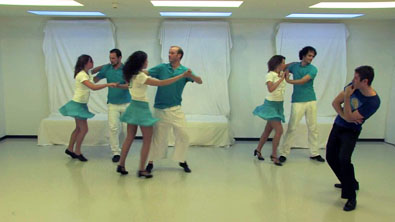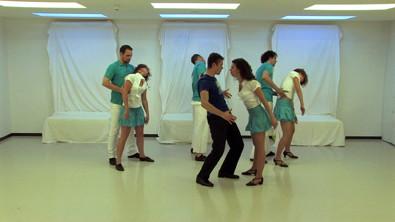

|
|
| Maartje C. de Jong - Dance your PhD |
|
|
|
Winner of the 'Dance Your PhD' contest 2010 in the category Biology:
|
| How does your brain analyzed visual information? |
|
Text explaining the dance: |
|
'I saw it with my own eyes!' We tend to believe what we see with our eyes is real and accurate. What we often do not realize is that our eyes register only a reflection of the outside world. To reconstruct reality from this reflection we have to rely on inferences and assumptions. It is like putting together the pieces of a puzzle without any knowledge about the whole picture. Our brain does this without our conscious awareness. In a split second it organizes and interprets incoming visual information to form a stable and meaningful image of the world around us. The brain does not analyze all the incoming information in detail, though. Only the most relevant or interesting part is permitted through the 'gateway to consciousness'. The rest of the information you are not aware of. For example, when you concentrate on your television set you will not see the painting hanging above it on the wall. Every individual also has internal neural factors, such as memory, that influence the brain's interpretation of information. For example, when you have experienced something before, it is hard to see things 'differently' on a second encounter. The information registered by your eyes intermingles with a blueprint of the previous encounter you have stored in your memory. Your image of the outside world thus is a mixture of incoming visual information and internal neural factors. Therefore, it is a personal experience unique to you. 'You look with your eyes, but you see with your brain!' Our video explains the basics of how the brain analyzes visual information. You see a man ('the observer') watching a movie-clip on his laptop. The visual information presented on his laptop is registered by his eyes and translated into neural signals that enter his brain. Through dance we portray what happens inside the observer's brain. The leading dancer in the video, who can be recognized by the brain depicted on his clothing, represents the observer's internal neural factors, such as his goals and experiences. The dancers with an information-icon depicted on their clothing ('the i-dancers') represent the incoming visual information. In the observer's brain the visual information is organized and features that belong together are grouped (the leading dancer puts the i-dancers in the correct positions). Then, one piece of the visual information is selected for detailed neural analysis (in the foreground the leading dancer examines one of the i-dancers). The neural processing of the other information is suppressed (the other i-dancers make slower movements in the background). When the observer is interrupted by a phone call the neural analysis of the visual information dies out (all dancers fall on the ground). After the phone call the observer looks at his laptop again. He now remembers the movie-clip on his laptop. The organization of the visual information inside his brain is more efficient than before (the leading dancer groups the i-dancers fast and deliberately). Also, the visual information has become predictable (the leading dancer knows the choreography of the i-dancers). For detailed neural processing the observer's brain easily selects the same piece of visual information as before (the leading dancer guides his favorite i-dancer to the foreground again), which now interacts with the internally stored blueprint (the leading dancer and the favorite i-dancer dance together). 'The eye sees only what the mind is prepared to comprehend.' Henri-Louis Bergson 1859-1941. French philosopher and Literature Nobel Prize winner in 1927 |


|
|
[Photos of rehearsals] |